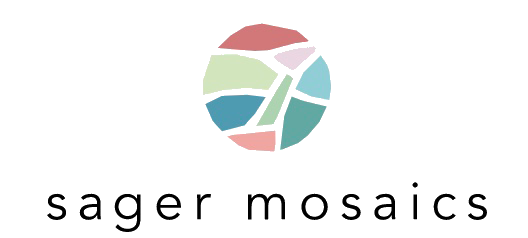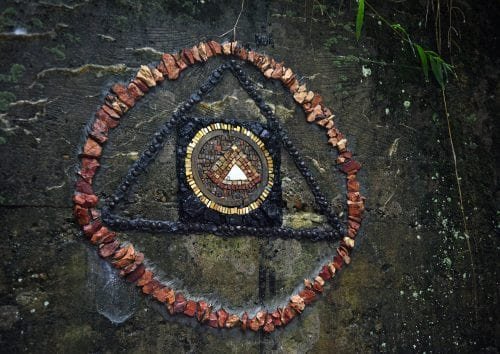To write … or not to write.
Photo by Celeste Van Kirk/Observer-Reporter
Rachel Sager at The Ruins Project a long-term mosaic art installation on her property in Perryopolis on Tuesday, August 5, 2017.
I write this in the afterglow of a satisfying Ruins Project week in which the power of the artistic sensibility was tapped. The further I travel through life as a working artist, the clearer it becomes that time, as an element to creativity, is not linear. I have read that it is circular, but as a lover of historical timelines, I’m still thinking on that one. I do know that the artist’s path is a well- beaten path. This well-worn nature does not fool me into believing that it is safe. To the contrary, this path is littered with dead, dying and broken artists. I quote the ideas of Steven Pressfield regularly and his breathing of life into the word Resistance in The War of Art. If you want to walk the walk, read it. And then read it again.
Dynamic, not static.
Beatrice in battle gear
An artist worth the title is always charging forward. On a good day, I imagine myself in full chain mail regalia astride one of those heavy, draft horses with a big smile on my face. Or sometimes a scowl. It depends on the day. Tiptoeing one morning, bulldozing the next. But always a dynamic movement into the things that are outside of the establishment, the known, the way things are or always have been. The artist’s refusal to live inside of a prescribed outline, gives him extraordinary power. We can imagine things that don’t need definition. We can create things that refuse classification. The Ruins Project stands as the embodiment of the great power of imagination. I often refer to sections of its blank concrete walls as the wild west.
Wild West of The Ruins Project
Artists love to re-purpose things. Who else but an artist would decide to turn an abandoned coal mine into the biggest creator-mosaicist substrate ever? I use the term creator-mosaicist to describe mosaic work that does not copy but comes from the deep kernel of the soul of an artist. Credit, as always, to Maestro Marzi for coining the phrase.
The Ruins structures were originally built as the power house of the mine. I’ve always responded strongly to that word; power. Maybe it’s because I understood, even if subconsciously, that creative power is the kind that has no ceiling. It feeds on its own energy and if channeled by a self-aware artist, is limitless. It bursts forth and says, Behold me!
Photo by Celeste Van Kirk/Observer-Reporter
A mosaic title Alchemy by Rachel Sager, Julie Sperling and Helen Miles made with red dog, coal, shale, gold, iron ore pellets, ancient pot shards and sea-worn ceramic at The Ruins Project in Perryopolis, PA.
I have come to feel a bit sad when I see artists wanting to define their work using someone else’s language. The pompous artspeak vocabulary that stands today, is a tragic example of the establishment controlling the imaginers. The establishment, as in, those who make the rules that an artist believes she should follow to be successful; museum directors, curators, the people who create grant applications, critics who don’t make art. This sclerotic dialect works very hard to distance the viewer from genuine intimacy. The human experience of art should be visceral, as in instinctual and seated in the gut. Tortured phrases, like this one that I made up for fun, work hard to separate a person from this direct, earthy connection to art:
“My work, being intuitively process-based, traverses the idea of geographical placement while simultaneously communicating historical texture, the gravity of ancestry and a proletariat mentality. The materiality driven goals are transcended only by a more universal respect for language within the medium. Sometimes the narratives that I construct ask conceptual questions about the human experience of locality. Often, my work challenges preconceived understandings about marginalized groups.”
Where is the humanity in that statement, I ask?
Things that aren’t here anymore by Jody Best and Rachel Sager
Now, read the more accessible and, hopefully, clear:
“I build art about places because my place defines who I am. I come from a beautifully imperfect corner of the world and it has stamped a deep, sometimes bloody mark, into my soul. I feel pride for the people I come from; coal miners, farmers, steelworkers, people who build things. I go out into the fields and dig up pieces of history that I transform into lines of mosaicked communication. I tell stories in stone. Sometimes those stories are big and sweeping like geologic time. Sometimes they are small but mighty and speak of forgotten people.”
I know, and of course, understand the process we must go through for show applications, grant proposals and all the things that make a working artist get stuff done. But when do we, as the ones who do the making and the heavy lifting, grip the reins of our own destinies and turn this giant, plodding monster of word control towards a clearer destination? That destination being those powerful moments in time when a person stands in front of our creation and becomes illuminated. That’s my goal, as the artist. To illuminate. To shine a great light into the cave of shadows that Plato describes in his time- tested allegory.
Photo by Celeste Van Kirk/Observer-Reporter
Through an opening in the wall shows a mosaic title Alchemy by Rachel Sager, Julie Sperling and Helen Miles made with red dog, coal, shale, gold, iron ore pellets, ancient pot shards and sea-worn ceramic at The Ruins Project in Perryopolis, PA - Tuesday, August 5, 2017.
2017 was the year I decided to not write another artist statement. Not because I don’t love to write them. I love to write and I love to write about art. But the painful act of reading so much simply bad art writing or the dreaded artspeak has prompted me to ask, “Why are you writing this, Rachel?” Does this piece need words? Do words help to illuminate this image? I now believe that if your art cannot lift someone up or challenge them on its face, then the story you tell about it may just be a candy coating that covers what’s really important; the good stuff with the chocolate center.
I write this essay knowing full well that I will write more artist statements. My purpose in claiming to stop is to create a line in time for my dynamic artist self. I will push forward, knowing the pre-2017 art writing happened because I knew each piece needed a statement from me to prove its worth. My post-2017 self understands that the most important thing is the illumination of the spirit, both my own and anyone who chooses to contemplate my art. The words may or may not be necessary. Maybe this small act of rebellion is just one step forward on that well-worn but still dangerous artist path. But, as all the people who understand how things get done, and as my great-grandmother loved to say, “it doesn’t take long, once you get at it”.
Sign up for the newsletter
You will receive one or two high quality blogs a month about anything from the state of contemporary mosaic, the power of dreams, the art of foraging to the latest updates on The Ruins.






